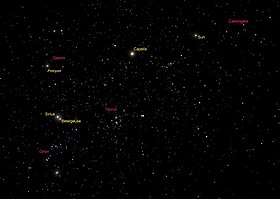View from this system

The sky from Alpha Centauri AB would appear much as it does from the Earth, except that Centaurus would be missing its brightest star. The Sun would appear as a yellow star of apparent magnitude +0.47, roughly the same as the average brightness of Betelgeuse from Earth. It would be at the antipodal point of Alpha Centauri AB's current right ascension and declination, at 02h 39m 35s +60° 50′ (2000), in eastern Cassiopeia, easily outshining all the rest of the stars in the constellation. With the placement of the Sun east of the magnitude 3.4 star Epsilon Cassiopeiae, nearly in front of the Heart Nebula, the "W" line of stars of Cassiopeia would have a "/W" shape.note
Comments
Post a Comment